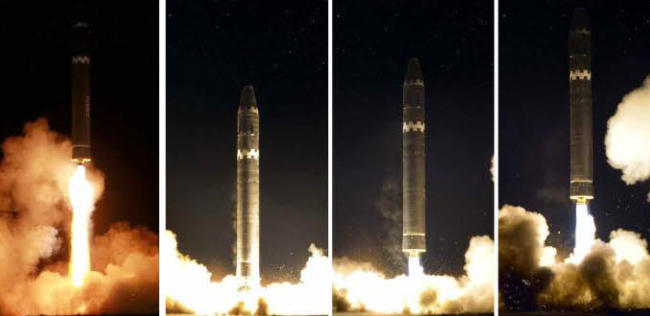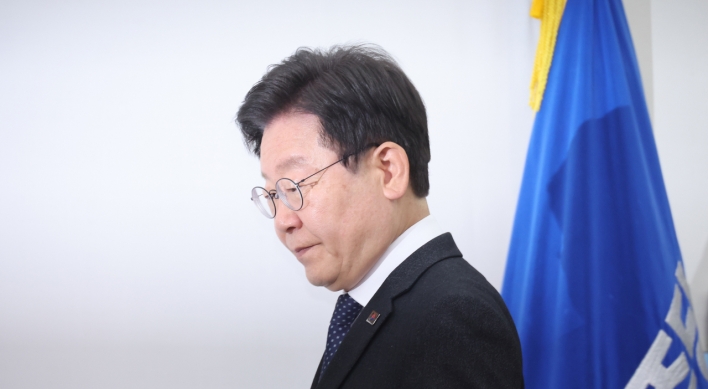NK’s latest missile a ‘new type’: S. Korean military
By Jung Min-kyungPublished : Nov. 30, 2017 - 17:39
North Korea’s latest intercontinental ballistic missile is a newly developed weapon rather than a variant of existing models, South Korea’s military said Thursday.

“(We) are assessing that the Hwasong-15 is a new type,” Army Col. Roh Jae-cheon, spokesman for the Joint Chiefs of Staff, said at a press briefing.
The announcement follows North Korea’s release of photos that showcased updated features of its new intercontinental ballistic missile Thursday.
“There are clear differences in the appearance of the Hwasong-15’s warhead, the connection part between the first and second stage (of the missile), and the overall size.”
The photos depicting Wednesday’s liftoff of the Hwasong-15, which the North said was an upgraded model of the two-stage ICBM Hwasong-14, portrayed a much rounder warhead shape compared to its previous version. The photos were published by its state-run newspaper Rodong Sinmun.
Experts here said that the new warhead design is linked to North Korea’s efforts to build a missile that can carry multiple warheads.
Japanese broadcaster NHK reported that the North Korean missile broke into three pieces before falling into the East Sea, which sparked concerns that the North had succeeded in building a multiple re-entry vehicle. The vehicle enhances the warheads’ first-strike proficiency with its capability to hit different targets with multiple missiles.
“It seems the rounder warhead shape and the part that protects the re-entry vehicle was designed in consideration to carry multiple warheads in the future,” Chang Young-keun, a missile expert at Korea Aerospace University, told The Korea Herald.
Chang also suspected a technological upgrade in the engine system.
“For the first-stage rocket, the North seems to have clustered two Paektusan rocket engines to increase its overall flight durability and range,” said Jang, highlighting how Hwasong-14 was equipped with only one Paektusan engine.
“North Korea seems to have changed the engine system for the second-stage rocket,” he added.
“Although it is difficult to determine whether the engine is solid-fueled at the moment, there’s a possibility that it carries a bigger fuel tank and more vernier thrusters.” Thrusters refer to the device used to control and stabilize the missile, according to Chang.
Another expert also said there were the first-stage rocket was equipped with two engines, a sign that it was a new type of missile.
“There are two engines in the first stage rocket -- it’s a new type,” Kim Dong-yup, a professor at Kyungnam University’s Far East Institute said in a Facebook post.
“(Considering the engines), its altitude and 53-minute flight time, it is capable of striking the entire US mainland.”
There were also clues hinting at the change in the length of the missile, as it was carried on a transporter elector launcher with a total of 18 wheels, whereas the Hwasong-14 was transported on a 16-wheel vehicle. Rodong Sinmun mentioned its new TEL with nine wheels on each side in an article released Wednesday.
On Wednesday, the Hwasong-15 reached an altitude of around 4,500 kilometers and flew 960 kilometers before landing in the East Sea, according to South Korea’s Joint Chiefs of Staff. It puts the US mainland within its target range and is capable of carrying a heavy nuclear warhead, the North’s mouthpiece Korea Central News Agency said.
Experts in both South Korea and the US said it would have a range of more than 10,000 to 13,000 kilometers if launched at a range-maximizing trajectory, which could easily reach Washington.
But many believe North Korea has yet to secure the missile’s atmospheric re-entry technology, a core element in completing its ICBM program. As an ICBM re-enters the atmosphere and falls at a top speed of Mach 24, it must endure temperatures of 6,000-7,000 degrees Celsius.
North Korea claimed that it had completed its “nuclear force” while underlining that its new ICBM is capable of hitting all areas of the United States and delivering a “super-sized heavy” nuclear warhead, in a separate Rodong Sinmun article.
Meanwhile, Seoul’s Unification Minister labeled the announcement a “hasty declaration.”
“Until recently, there were indications that North Korea has faced limits in connection with atmospheric re-entry technology, guiding and sending (an ICBM) to an intended point, and blowing up (the warhead) at a timing it wants,” he said at a Seoul Forum on Thursday.
By Jung Min-kyung (mkjung@heraldcorp.com)




![[Herald Interview] 'Amid aging population, Korea to invite more young professionals from overseas'](http://res.heraldm.com/phpwas/restmb_idxmake.php?idx=644&simg=/content/image/2024/04/24/20240424050844_0.jpg&u=20240424200058)












![[KH Explains] Korean shipbuilding stocks rally: Real growth or bubble?](http://res.heraldm.com/phpwas/restmb_idxmake.php?idx=652&simg=/content/image/2024/04/25/20240425050656_0.jpg&u=)

